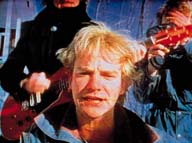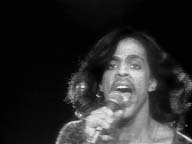L'edicola digitale delle riviste italiane di arte e cultura contemporanea
Flash Art Int. (1999 - 2001) Anno 33 Numero 211 March-April 2000
Candice Breitz
David Hunt
Fighting Words

Franz Ackermann
Wolf-Günter Thiel and Milena Nikolova
n. 216 Jan-Feb 2001
Shangai Biennale
Satoru Nagoya
n. 216 January-February 2001
Aperto Albania
Edi Muka
n. 216 January-February 2001
Cecily Brown and Odili Donald Odita
n. 215 November-December 2000
Cai Guo-Qiang
Evelyne Jouanno
n. 215 November-December 2000
Aperto New York
Grady T. Turner
n. 213 summer 2000



David Hunt: there seems to be a renewed interest in dystopic language as a way of destroying old artistic forms. Smithson, Deleuze, and even Burroughs are routinely trotted out to invoke dystopic mantras. More recently, other resistance narratives have grown to counter the undifferentiated electronic Babel of the Internet. I'm thinking for example of hip-hop's verbal flows, or the acute sense of dystopia that pervades your Babel Series (1999) installation. Candice Breitz: It's certainly difficult to reconcile oneself to artistic strategies that have a utopian bent at this moment, given the accelerated pace at which every possible strategy of aesthetic resistance is absorbed, packaged, and marketed as product in our current culture. Thomas Crow cannily pointed out years ago, that for more than a century now, artists have been the research and development arm of the fashion and entertainment industries, where their difficult and innovative ideas are repackaged for easy consumption. The question then, is what strategies remain viable at a moment in which narratives of resistance are as utterly available to the mainstream market as fast food (think of Benetton's ongoing allusions to global harmony or The Gapís current launch of a fashion line called 1968). This is perhaps one means of explaining the dystopic tone of much current production, including my own, which must in a sense admit its impotence in relation to the all-pervasive presence of phenomena such as Pokemon and Celine Dion, even as it strives to provide forms of experience that exceed or at least point to the limitations of such cultures. My own sense is that it is necessary to somehow acknowledge within oneís practice, the degree to which resistance to the merging of the realms of art and the culture industry is naÔve, if not futile.... At the same time, it is neither necessary nor desirable to celebrate this increasingly inevitable merger.
David Hunt: How does this square with your Babel Series installation which seems to merge pop culture with linguistic critique?
Candice Breitz: The Babel Series consists of seven constantly stuttering video-tapes, each of which steals a fragment of footage from the history of music video. Together, the videos bang a cacophonous baby talk out of a series of dissonant beats, a baby talk that approaches sheer pandemonium. A small fragment appropriated from Madonnaís song Papa Don't Preach, has her moaning Pa-Pa-Pa-Pa. Another video has Freddie Mercury gabbling Ma-Ma-Ma-Ma...Elsewhere, George Michael whimpers Me-Me-Me-Me..., while Grace Jones insists No-No-No-No... The bodies of the performers are frozen in language on each flickering screen-constantly emerging and disintegrating as they articulate. In its staging of primal language as always already tainted, the Babel Series alludes to the challenges facing subject formation in a world in which children often learn their first words by watching television or singing along to pop songs. The installation implies that the entry of the subject into language is inevitably inflected through the global media, restaging concrete poetry such that the utopian aspirations of earlier artists to universal language are jarringly displaced by the infernal universality of the media industry. The resulting discordant environment owes as much to the new poetics of Dada, Futurism, and the Soviet avantgarde as it does to Andy Warhol and MTV.
DH: Speaking of Andy Warhol - his influence remains overwhelming for artistic practice... What do you see as the validity of Warhol's ideas in today's world?
CB: The conflation of Art-Business and Business-Art - perhaps Warholís most notorious legacy - has proven, for the next generation, to be less a matter of creative choice or subjective whim than a condition that is dictated by social and economic circumstances that are much larger than any individual artist. Andy would no doubt have relished the next inevitable phase, which is reaching an unprecedented level of intensity right now: the collapse of Art-Fashion into Fashion-Art.
DH: The Babel Series installation alludes to the extent to which our entry into language is inevitably inflected through the global media, but it seems like your latest video installation Karaoke (2000) is a broader look at the construction of identity in its entirety. Can you briefly explain the premise of Karaoke?
CB: The Karaoke installation envelopes the viewer within a circle of 10 television monitors, each of which presents a tightly-framed shot of a different face. The sheer lack of harmony that is experienced as one stands among the noisy televisions may at first prevent one from realizing that each of the faces is in fact performing its own rendition of the same love song Killing Me Softly. Since no effort is made to synchronize the playback of the different video-tapes, the possibility of lyrical unity among the diverse range of singers is ruled out immediately, in favor of a grating pandemonium of competing voices. What quickly becomes apparent, is that the words of the song are not so much being spontaneously sung as they are being tentatively "re-sung," dictated to the singers by Karaoke videos. The singers thus become temporary vehicles for words that are never quite theirs. The love song, language at its most contagious, here becomes emblematic of the violence that is intrinsic to language, for though the love song is the very instance in which we would unburden our most intimate feelings, reveal our most interior thoughts, we have no choice but to do so by means of sentiments and phrases that are derived from a repertory that is known to others and externally prescribed.
DH: How did you choose the actors for your Karaoke piece?
CB: Not necessarily evident as you experience the work, is the fact that none of the Karaoke performers is a native English speaker. I am interested in the formal similarity between Karaoke and the language cassettes used by millions to learn a foreign language. The singers were found through a search for individuals whose mother tongue could be any language except English, resulting in a congregation of amateur performers from language backgrounds as diverse as Tamil, Russian, Vietnamese, and Spanish. You could say that the video installation mimics "We are the World" universalism or Benetton utopianism even as it reflects on the sacrifices and losses that are inevitable in a too easy aesthetic staging of a unified public sphere. Despite the circular arrangement of the monitors, each singer seems utterly oblivious to the presence of the others. Neither does one have the sense that the individual singers are truly present to their own performances, as their complete absorption in the words on the screens before them somehow evacuates them in the very moment of expression, "He sang as if he knew me, in all my dark despair. And then he looked right through me as if I wasn't there."
DH: An interest in the tyranny of language seems to resonate in many of your works, none of which seem to vest faith in language as a means of communication. Rather, language often appears mangled, contorted, violent - giving your work a dark edge.
CB: At some level, Karaoke is an intensive language laboratory, one that has the enrolled students duly reiterating that which is dictated to them, not the nuts and bolts of a language in this case, but the pre-scripted words of a pop song, along with a familiar repertoire of pouting, crooning, and eyelid-lowering. Their self-presentation is immediately recognizable as a vocabulary of sorts, one that resonates jarringly against the dissonant lyrics and asynchronous music issuing forth from the multi-monitor installation, as language is pushed further and further towards opacity, finally collapsing into nonsensical chaos.
David Hunt is a critic based in New York.
Candice Breitz was born in Johannesburg in 1972. She lives and works in New York.
Selected solo shows: 2000: Francesca Kaufmann, Milan; Chicago Project Room; Centre díArt Contemporain, Geneva; 1999: Rüdiger Schüttle, Munich; Roger Björkholmen, Stockholm; 1998: Johnen & Schöttle, Cologne; Sala Mendoza, Caracas.
Selected group shows: 2000: Kwangju Biennale (South Korea); "The Wounded Diva," Kunstverein, Munich; "Korper," Fotogalerie, Vienna; "The Anagrammatical Body," ZKM, Karlsruhe; 1999: 6th Istanbul Biennial; Kunsthaus, Murzzuschlag; "Global Art 2000,"Museum Ludwig, Cologne; 1998: XXIV Bienal de Sao Paulo; 1997: 2nd Johannesburg Biennale.


